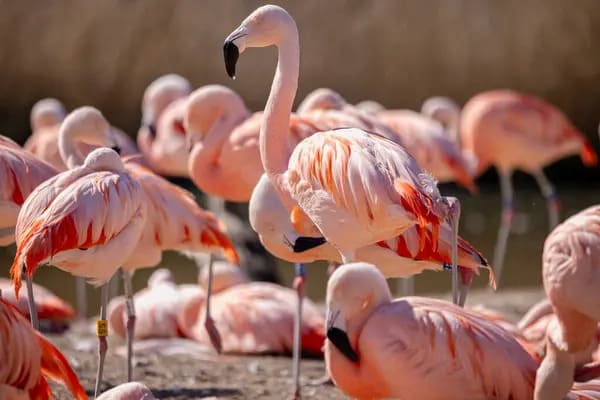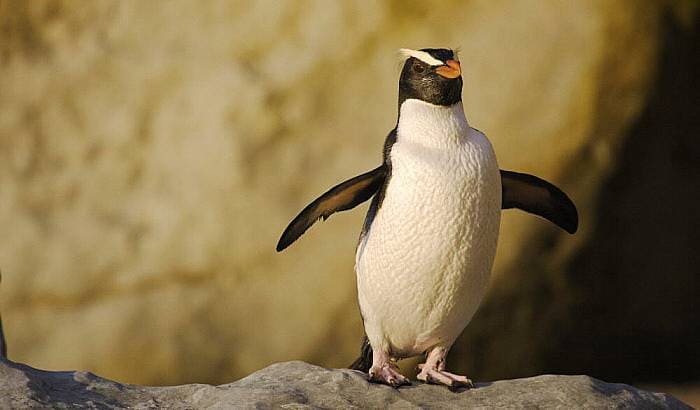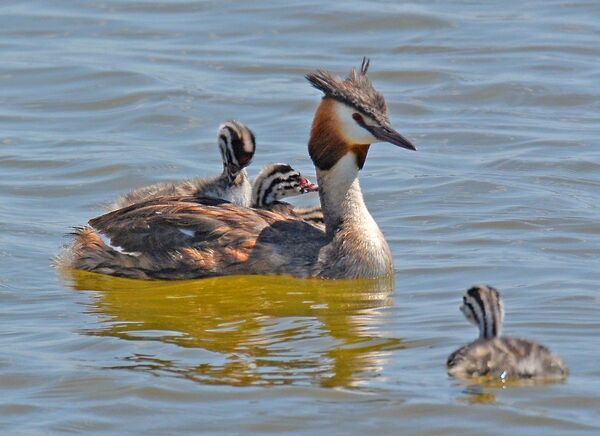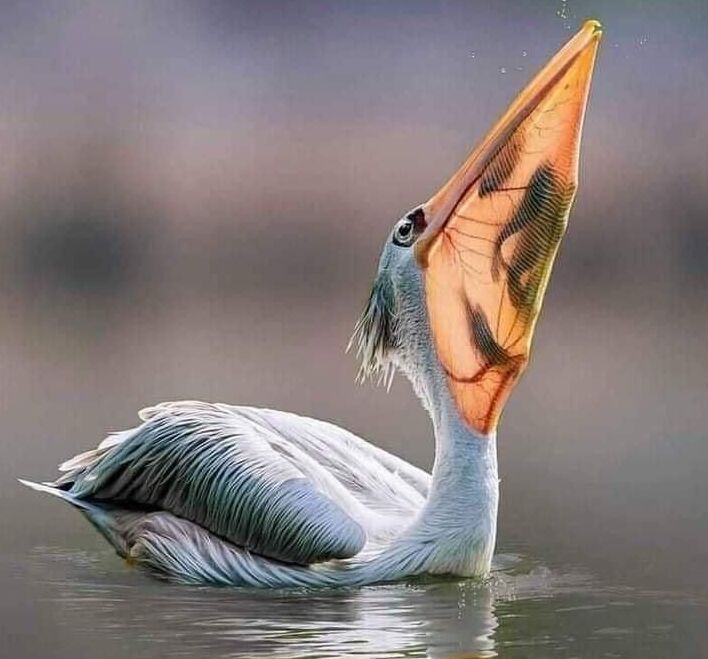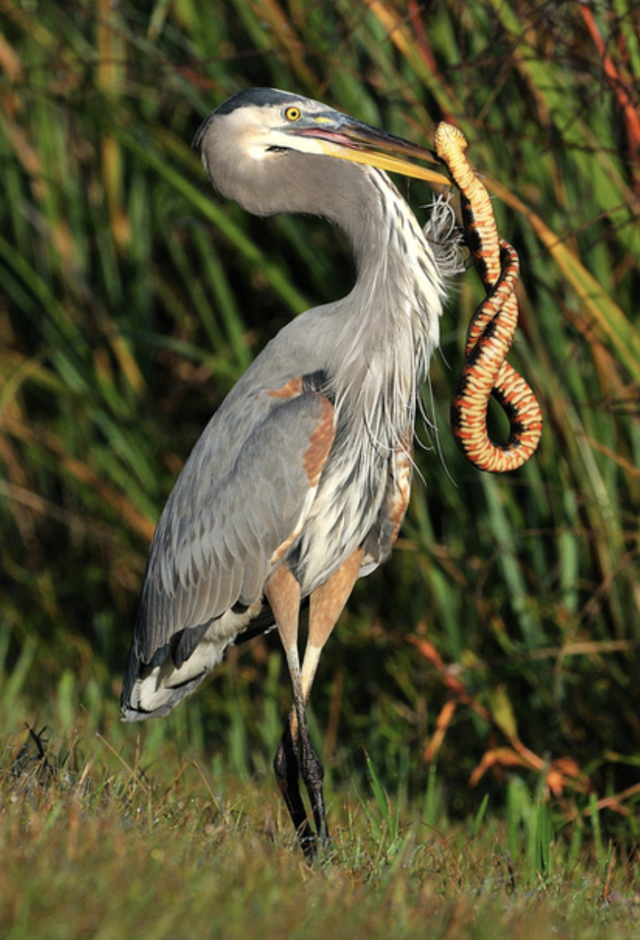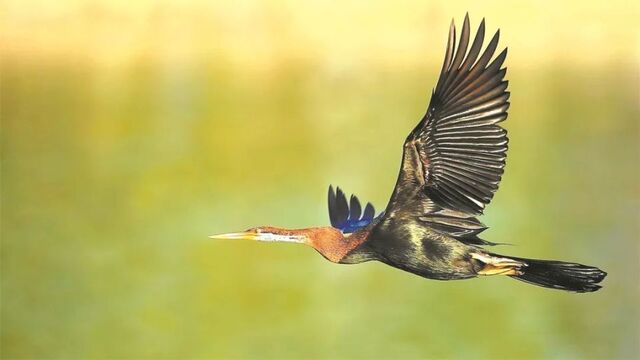Phalacrocorax carbo
IUCN
LCBasic Information
Scientific classification
- name:Phalacrocorax carbo
- Scientific Name:Great Cormorant,Black Shag,Cormorant,White-breasted Cormorant,Heron, river cormorant, water crow, osprey, 鷧 (pronunciation meaning), black ghost, black fish man
- Outline:Wading birds
- Family:P.carbo Phalacrocorax Phalacrocoracidae Suliformes Aves
Vital signs
- length:720—900mm
- Weight:2kg
- lifetime:13-15years
Feature
The whole body is almost completely black with a green-brown metallic luster. During the breeding season, there are white filamentous feathers behind the head and a white spot on the lower flank. These characteristics disappear during the non-breeding season. The body feathers of young birds are brown. The iris is red, the beak is gray-black, and the feet are black-green.
Distribution and Habitat
It inhabits rivers, lakes, ponds, reservoirs, estuaries and swamps. It often perches on rocks or branches to dry its wings. Wild cormorants usually inhabit rivers and lakes. In summer, they nest on cliffs or tall trees near water, or on low trees in swamps. They are not very afraid of people. They often move around the seaside, lakeside and fresh water.
Appearance
It has a blackish sheen, a heavy bill, white cheeks and throat. During the breeding season, the neck and head are decorated with white filamentous feathers, and the flanks have white patches. Juveniles: dark brown, with dirty white underparts. The iris is blue; the bill is black, with the base of the lower bill exposed to yellow skin; the feet are black.
Details
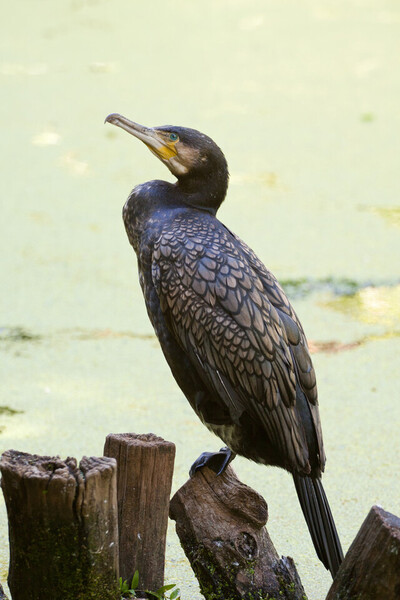
The cormorant (scientific name: Phalacrocorax carbo), also known as heron, river cormorant, water crow, osprey, 鷧 (pronounced and meaning), black ghost, black fish owl, etc., is a widely distributed seabird of the genus Phalacrocorax. It belongs to the genus Phalacrocorax of the family Phalacrocorax of the order Pelecaniformes. The body length is 720-900 mm, the wingspan is 1210-1490 mm, and the male and female are monotypic. The feather color is black with a purple metallic luster, and the iris is green. In breeding feathers, there are large patches of white on the sides of the head and neck. In non-breeding feathers, the white on the head and neck disappears; the beak is thick, the base of the beak and the throat pouch are orange-yellow, and the cheeks and throat are white; the neck and headdress of summer feathers have white silky feathers, which disappear in winter feathers, and there are white spots on both sides; sub-adult birds are dark brown, and the lower body is dirty white.
Distributed in North America, Europe, Russia, northwest and southern Africa, the Middle East, Asia, Australia, and New Zealand. In China, they breed in suitable environments all over the country, and gather in large groups in Qinghai Lake. They live in large and open rivers, lakes and reservoirs. They usually move in small groups, and sometimes the number can reach hundreds. They mainly feed on fish and crustaceans. After fishing, they often dry feathers in open areas near the water or on branches. The breeding season is from April to June, and each nest lays 3-5 eggs. The eggs are light blue or light green. The male and female parents take turns to incubate the eggs, and the incubation period is 28-30 days. After about 60 days of feeding by the parents, the young birds can fly and leave the nest, and they reach sexual maturity in about 3 years.
It is more common in southern China and has long been domesticated by the people for fishing. Due to long-term large-scale capture and environmental damage, the number of wild populations has become very scarce. The common cormorant is included in the "List of Terrestrial Wildlife with Important Economic and Scientific Research Value under State Protection" issued by the State Forestry Administration of China on August 1, 2000; it is a key protected bird in Hebei Province, China.
The head, neck and crest of the common cormorant in summer are black, with a purple-green metallic luster and mixed with white filamentous fine feathers; the upper body is black; the shoulders, back and wing coverts are copper-brown with a metallic luster; the feather edges are dark copper-blue; the tail is round, with 14 tail feathers, gray-black, and the base of the feather shaft is gray-white; the primary flight feathers are black-brown, and the secondary and tertiary flight feathers are gray-brown with a green metallic luster; the cheeks, chin and upper throat are white, forming a half ring, with the rear edge stained brown; the rest of the lower body is blue-black with a metallic luster, and there is a white spot on the lower flank. The winter plumage is similar to the summer plumage, but there are no white filamentous feathers on the head and neck, and no white spots on the flanks. During the reproductive period, there is a triangular white spot on each side of the waist. There are white filamentous feathers on the head and upper neck, and there is a not very obvious crest on the back of the head.
The iris is emerald green, the front of the eye is olive green, the exposed skin around the eye and the throat is yellow, the beak is thick, strong and long, cone-shaped, with a sharp hook at the tip, the upper beak is black, the edge of the beak and the lower beak are grayish white, suitable for pecking fish, and there is a small sac in the lower throat, which is orange-yellow. The winter plumage of the young bird is similar to that of the adult bird, but the color is lighter, the upper body is mostly dark brown, the head has no crest feathers, and the center of the chest and abdomen is silky white. The feather color of the cormorant is mainly black with a purple metallic luster. In the reproductive season, the male bird will grow many white silky feathers on its head and neck. The feet are black, the feet are hind, the toes are flat, the hind toes are longer, and they are fully webbed. It lives on the seashore and in lakes. When flying, the neck and feet are straight.
Size: Weight ♂1990-2250g, ♀1340-2300g; Body length ♂770-870mm, ♀716-836mm; Bill ♂64-75mm, ♀61-66mm; Wing ♂318-375mm, ♀337-342mm; Tail ♂185-220mm, ♀160-182mm; Tarsus ♂70-90mm, ♀61-78mm. (Note: ♂male; ♀female)
Habitat
Inhabits rivers, lakes, ponds, reservoirs, estuaries and swamps. Also often perch on rocks or branches to dry wings. Wild cormorants usually live in rivers and lakes, and nest on cliffs or tall trees near water in summer, or on low trees in swamps and lowlands. Not very afraid of people. They often move around the seaside, lakeside, and freshwater.
Habits
Migration
Most common cormorants are resident birds, especially those that breed in southern China, which generally do not migrate; those that breed north of the Yellow River generally migrate to the areas south of the Yellow River or the Yangtze River to overwinter in winter. In spring, they migrate to the northern breeding grounds in late March or early April, and in autumn, they generally begin to migrate from the northern breeding grounds to the southern wintering grounds in late September or early October. They often migrate in small groups, and sometimes in large groups of up to nearly a hundred.
Habits
They are used to collective action and have strong "organizational discipline". Like geese and ducks, they also form a V-shaped flight during long-distance migration. Sometimes they line up in a long line on the water, with their heads and necks erected, their beaks facing the same direction, and their bodies submerged in the water. From a distance, you can see a row of neat bird heads rising and falling in the waves.
Often move in small groups. Good at swimming and diving. When swimming, the neck is stretched straight upward and the head is tilted slightly upward. When diving, it first half jumps out of the water and then turns over and dives underwater. When flying, the head and neck are stretched forward, the feet are stretched backward, the wings are flapped slowly, and the flight is low, skimming the water surface. When resting, it stands on rocks or trees by the water, in a vertical sitting position, and flaps its wings from time to time. It is not very afraid of people. It often moves around the seashore, lakeside, and fresh water. When resting, it stands still on stones or tree stumps for a long time. It has strong flying ability. Except for the migration period, it generally does not leave the water. It mainly feeds on fish and crustaceans. When hunting, the head is immersed in the water to track the prey. The wings of the cormorant have evolved to help with paddling. Therefore, the cormorant mainly uses its flippers to swim in waters covered with seaweed, and in clear waters or waters with sandy bottoms, the cormorant uses both flippers and wings. In water with low visibility, cormorants often sneak up on their prey and suddenly stretch their necks to deliver a fatal blow with their mouths. In this way, no matter how agile the prey is, it will never escape. In the dim water, cormorants generally cannot see their prey clearly. Therefore, they can only hit the target with their keen hearing. After catching prey, cormorants must surface to swallow it. They make guttural grunts during the breeding season and are silent at other times. However, when they are in groups and have disputes over advantageous positions, they will make low "gu, gu" sounds.
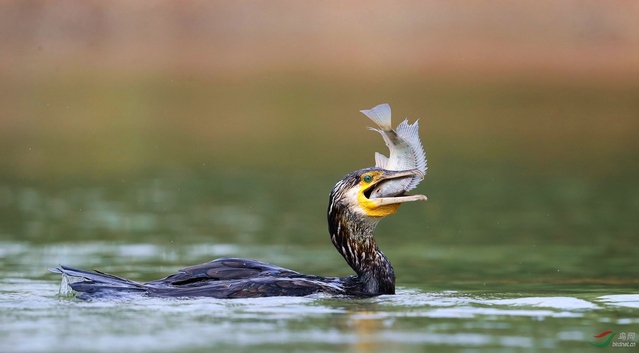
Diet
Feeds on various fish. They mainly hunt by diving. About 60% of their hunting areas are in the benthic zone. They dive 1-3 meters, the deepest they can dive is 19 meters, and the longest time can be up to 70 seconds. They can be called the diving champion among birds. After catching fish, they come to the surface to swallow them. A cormorant can catch more than 500 kilograms of fish a year. Sometimes they stand on rocks or trees near the water for a long time and watch quietly. After finding prey, they dive into the water to hunt.
Distribution: Afghanistan, Albania, Algeria, Angola, Armenia, Australia, Austria, Azerbaijan, Bahrain, Bangladesh, Belarus, Belgium, Bermuda, Bhutan, Bosnia and Herzegovina, Botswana, Brunei Darussalam, Bulgaria, Burkina Faso, Burundi; Cambodia, Cameroon, Canada, Chad, China, Democratic Republic of Congo, Côte d'Ivoire, Croatia, Cyprus, Czech Republic, Denmark, Egypt, Eritrea, Estonia, Ethiopia, Faroe Islands, Finland, France, Gabon, Gambia, Georgia, Germany, Ghana, Gibraltar, Greece, Greenland, Guinea, Guinea-Bissau, Hungary, Iceland, India, Indonesia, Islamic Republic of Iran, Iraq, Ireland, Israel, Italy, Japan , Jordan, Kazakhstan, Kenya, South Korea, North Korea, Kuwait, Kyrgyzstan, Lao People's Democratic Republic, Latvia, Lebanon, Lesotho, Libya, Lithuania, Luxembourg, Macedonia, Malawi, Malaysia, Malta, Mauritania, Moldova, Mongolia, Montenegro, Morocco, Mozambique, Myanmar, Namibia, Nepal, Netherlands, New Caledonia, New Zealand, Nigeria, Norway, Oman, Pakistan, Palestine, Philippines, Poland, Portugal, Qatar, Romania, Rwanda, Saint Pierre and Miquelon, Saudi Arabia, Senegal, Serbia, Slovakia, Slovenia, Solomon Islands, Somalia, South Africa, South Sudan, Spain (Canary Islands) , Sri Lanka, Sudan, Swaziland, Sweden, Switzerland, Syrian Arab Republic, Tajikistan, United Republic of Tanzania, Thailand, Tunisia, Turkey, Turkmenistan, Uganda, Ukraine, United Arab Emirates, United Kingdom, United States (Hawaii Islands), Uzbekistan, Vietnam, Western Sahara, Yemen, Zambia, Zimbabwe.
Introduced: Singapore. Origin uncertain: Guam. Migrant bird: Cape Verde, Christmas Island, Liberia, Liechtenstein, Federated States of Micronesia, Norfolk Island, Northern Mariana Islands, Papua New Guinea, Seychelles.
Breeds in the northern part of the northern hemisphere and winters in the southern part of the breeding grounds. Breeds in central and northern China, gathering in large groups at Qinghai Lake. Migrate through central China and winter to southern provinces, Hainan Island and Taiwan. Tens of thousands of cormorants winter in the Mai Po Nature Reserve in Hong Kong every winter, and some birds stay there all year round, which is rare in other places.
Reproduction method
The breeding season is from April to June. Usually, pairs are formed to nest together. When they arrive at the breeding grounds, pairs are basically formed. They nest on trees near lakes, riverbanks or swamps. Sometimes there are nearly 10 nests on a tree. Some nests are also built on rocks near lakes or rivers, on small islands in the middle of lakes, gravel islands in lakes or on coastal islands. The nest is made of dead branches and water plants. They also like to use old nests. Soon after arriving at the breeding grounds, they start to repair old nests and build new ones. Each nest lays 3-5 eggs, which are light blue or light green, oval, blunt oval or pointed oval, with a size of 51-70 mm × 34-49 mm, an average of 65 mm × 41 mm, and weighing 42-49 grams, an average of 46 grams. The male and female parents take turns to incubate the eggs, and the incubation period is 28-30 days. The chicks are late-maturing. When they are just hatched, they are naked and featherless. About 2 weeks after hatching, they are covered with down feathers, and flight feathers and tail feathers begin to grow at the same time. The male and female parents raise their chicks together. The chicks put their beaks into the pharynx of the parents to eat semi-digested food. After about 60 days of feeding by the parents, the chicks can fly and leave the nest, and they reach sexual maturity in about 3 years.
Protection level
Listed in the "National List of Terrestrial Wildlife with Important Economic and Scientific Research Values for State Protection" issued by the State Forestry Administration of China on August 1, 2000.
Listed in the 2012 Red List of Endangered Species of the World Conservation Union (IUCN) ver 3.1 - Least Concern (LC).
Population status
The common cormorant is relatively common and common in southern China. It has long been domesticated by the people for fishing. Due to long-term large-scale capture and environmental damage, the number of wild populations has become very rare and uncommon. According to the Asian Midwinter Waterbird Survey organized by the International Waterfowl Research Bureau in 1990 and 1992, 2,031 birds were seen in mainland China in 1990, plus 3,407 in Hong Kong and 130 in Taiwan, totaling 5,568 wintering birds; 273 birds were seen in mainland China in 1992, plus 1,473 in Hong Kong and 337 in Taiwan, totaling 2,083 wintering birds. The population has dropped by more than half. In Asia as a whole, the wintering population in 1990 was 19,305 in East Asia, 20 in Southeast Asia, 10,371 in South Asia, and 2,505 in Southwest Asia, totaling 42,201 birds; in 1992, there were 40,495 birds in West Asia, 7,547 in South Asia, and 2,126 in East Asia, totaling 50,168 wintering birds in Asia, with a slight increase in the population.
The species has a wide distribution range and is not close to the critical value of vulnerable and endangered species survival (distribution area or fluctuation range is less than 20,000 square kilometers, habitat quality, population size, and fragmented distribution area). The population trend is stable, so it is evaluated as a species without survival crisis.
On March 25, 2023, during the wild bird monitoring activity in the spring bird migration season of Baiyangdian organized by Xiongxian Forestry Comprehensive Service Center of Xiongan New Area, bird-loving and bird-protecting volunteers recorded more than 200 wild common cormorants (lú) (cí), which is the largest single record of wild common cormorant populations in Baiyangdian.
Related knowledge
Cormorants have been domesticated for fishing since ancient times because of their superb fishing skills. They swim quickly in the water and catch fish with their sharp hooked mouths. In Yunnan, Guangxi, Hunan and other places in China, people still domesticate cormorants for fishing. In the rivers, lakes and seashores in southeastern China, it was common to see several or more than a dozen trained cormorants (commonly known as ospreys and water ducks) standing on narrow boats, working hard to help fishermen catch fish. About 60% of their hunting areas are in the benthic zone. Fishermen rowed their boats to where there were many fish, and rows of cormorants flew out of the boats, like wild ducks, swimming around in the water, diving into the water for a while, and then floating on the surface. When they found fish, they dived 1-3 meters, and the deepest they could dive was 19 meters, and the longest time could be up to 70 seconds. They can be called the diving champions among birds, using their conical mouths with fishing rods to catch those cheap small fish, or small fish with poor swimming ability. If they encounter big fish, two or three will work together, some pecking at the head, some biting at the tail, and pushing and biting it to the side of the boat, so that the fishermen can immediately catch it with a net. A cormorant can catch more than 500 kilograms of fish a year.
When the cormorant chicks are about 60 days old, they can be put into the water. After 100 days old, they can gradually follow the adult cormorants to learn to fish. After 150 days old, they can gradually start normal fishing. When training to fish, a ring made of sedge, hay or other grass stems (special copper rings can also be used) should be put on the cormorant's neck so that it can only swallow small fish and cannot swallow larger fish. Every time the cormorant catches a big fish, a small fish should be fed after taking the fish to encourage it to go into the water to fish more often. The fish they "vomit" do not enter the esophagus, but are temporarily stored in the throat sac at the bottom of the mouth. At the beginning of training, you can also tie a lot of ropes to the feet of the cormorants, and tie the other end of the ropes to the shore of the river port. Put the cormorants in the water and ask them to go into the water to catch fish. When they catch fish, the trainer will make a special call to call the cormorants back to the shore, and then feed them with small fish. After eating, drive them back into the water and ask them to fish. After training every day like this for about a month, you can use a small boat, let the cormorants stand on both sides of the boat, and then rock the boat to a certain place, and drive them into the water to catch fish. After more than a month of training, they can be completely tamed and listen to the fisherman's command.

